

16356.pdf. 26140.pdf. Sector Insight (interactive): youth fashion. Trends.

Customer Loyalty Programs adopted by Fashion Brands. The fashion industry is a competitive sport.
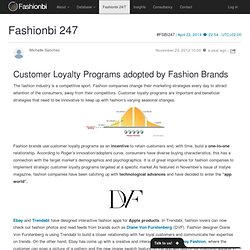
Fashion companies change their marketing strategies every day to attract attention of the consumers, away from their competitors. Customer loyalty programs are important and beneficial strategies that need to be innovative to keep up with fashion’s varying seasonal changes. Fashion brands use customer loyalty programs as an incentive to retain customers and, with time, build a one-to-one relationship. According to Roger’s innovation/adopters curve, consumers have diverse buying characteristics; this has a connection with the target market’s demographics and psychographics. For and Against: Luxury Brand High Street Collaborations - Jobbook News.
Luxury Society investigates why luxury brands partner with high street retailers and what it can cost them in terms of brand equity.

In our recent exploration of Celebrity Marketing in Luxury Communications we explained the two facets of luxury according to branding expert Jean-Noël Kapferer and luxury industry executive Vincent Bastien. “Luxury for oneself and luxury for others,” explained the duo. “To sustain the latter facet it is essential that there should be many more people that are familiar with the brand than those who could possibly afford to buy it for themselves.”
Rising cost of clothes could signal end to 'cheap chic' The days of "cheap chic" and throwaway fashion could be numbered, because the cost of clothes is rising at its fastest rate for nearly 15 years.

The "fast fashion" trend, where T-shirts sell for £2 and jeans are priced at less than a fiver in supermarkets, is being battered by big increases in the cost of cotton, labour and transport. Figures show the cost of clothing jumped 3.7% between July and August – the biggest month-on-month increase since the Office for National Statistics (ONS) started compiling the data in 1997. How Burberry Is Doing Digital Marketing Differently. This article titled “The digital hard-sell behind Burberry’s traditional image” was written by Sarah Butler, for The Guardian on Wednesday 10th July 2013 17.42 UTC It may have been founded 156 years ago, but Burberry is harnessing ground-breaking marketing techniques to put it at the forefront of fashion.
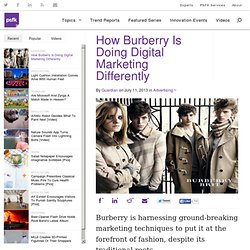
Where once luxury labels fought shy of the internet, believing it would cheapen their image, Burberry is now seeing its fastest growth in online sales as it embraces social media and blurs the boundary between its physical stores and the digital world. Carol Fairweather, chief financial officer, says a presence on Chinese sites such as Sina Weibo (the country’s version of Twitter), Youku (similar to YouTube) and Douban is helping Burberry outperform rival brands in the region. Fashion is fast to stay 'on trend' Zara, the retail fashion brand of Spanish multinational clothing company Inditex, arguably introduced the concept of “fast fashion” with its goal to closely couple trends and customer demand.
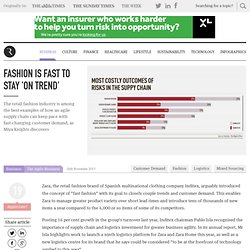
This enables Zara to manage greater product variety over short lead times and introduce tens of thousands of new items a year compared to the 4,000 or so items of some of its competitors. Posting 16 per cent growth in the group’s turnover last year, Inditex chairman Pablo Isla recognised the importance of supply chain and logistics investment for greater business agility.
In its annual report, Mr Isla highlights work to launch a ninth logistics platform for Zara and Zara Home this year, as well as a new logistics centre for its brand that he says could be considered “to be at the forefront of technology applied to this area”. Having an agile supply chain is a distinct advantage as it allows a retailer to bring ‘hot’ products to market quickly and capitalise on demand. Chinese consumers: Doing it their way. IN THE the heart of old Shanghai is a magnificent villa that serves as the workplace of Guo Jingming, a provocative young film-maker.
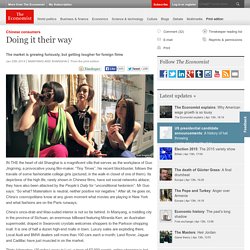
“Tiny Times”, his recent blockbuster, follows the travails of some fashionable college girls (pictured, in the walk-in closet of one of them). Its depictions of the high life, rarely shown in Chinese films, have set social networks ablaze; they have also been attacked by the People’s Daily for “unconditional hedonism”. Mr Guo says: “So what?
Materialism is neutral, neither positive nor negative.” After all, he goes on, China’s cosmopolitans know at any given moment what movies are playing in New York and what fashions are on the Paris runways. China’s once-drab and Mao-suited interior is not so far behind. Thirty kilometres (20 miles) away in Luxi, a town of 57,000 people, online shopping is hot. In the 1950s and 1960s the world economy was transformed by the emergence of the American consumer. Besides, consumption has not fallen in absolute terms. The future of shopping: from high street to iStreet. Fast Fashion Systems: Theories and Applications. Dr.
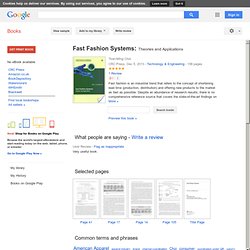
Tsan-Ming Choi (Jason) is currently an Associate Professor in Fashion Business at The Hong Kong Polytechnic University. Over the past few years, he has actively participated in a variety of research projects on supply chain management and applied optimization. Fashion Marketing: Contemporary Issues. Explicit cookie consent. Future Success in Retail: Speed May Not Be the Only Answer - Business Insider.